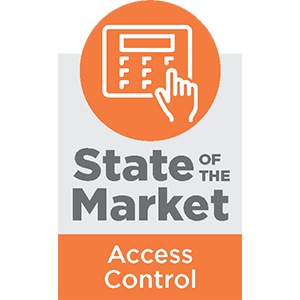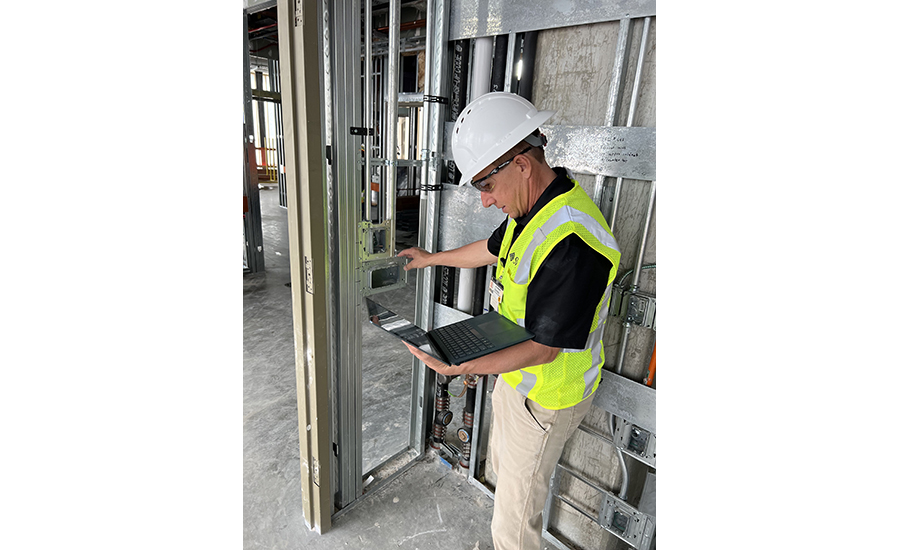According to SDM’s 2023 Industry Forecast, more than 1 in 2 (56 percent) security professionals expect revenue from access control systems (on-premise and cloud-based) to increase in 2023, marking a healthy 10-point jump from the previous year.
Pull back the view on the electronic access control (EAC) market and the rise in revenue among Industry Forecast respondents would seem consistent with various market research reports that generally have the North America region growing at a compound annual growth (CAGR) of around 9.5 percent. EAC sales revenue totaled around $4.4 billion in 2022, according to Future Market Insights. The region’s market size is projected to surge from $4.7 billion in 2023 to around $12.1 billion by 2033.
Ahead, numerous access control specialists provide insight and perspective on a range of topics, exploring key growth drivers for technologies and services, sector performance expectations for 2023 and beyond, top channel challenges and much more.
Assessing Current Market Forces
Ender users’ perceptions about access control systems have evolved significantly from 2020 to the present. Many positive shifts have been observed even since last fall when HID released its 2022 State of Access Control report, which revealed how the pandemic helped spur the adoption of contactless, secured and seamless technology solutions that reduced or eliminated physical touchpoints.
According to the 2022 report, both biometrics and mobile IDs were growing in popularity — 32 percent of respondents said they were actively using mobile IDs, while another 30 percent said the same about biometrics technology — whether that be fingerprint, facial or iris recognition. An additional 17 percent of respondents cited they were planning to upgrade to biometric access control or were already in the process of doing so, while another 19 percent said the same about mobile technology.
“We anticipated accelerating momentum behind these market trends, and this was validated in our March 2023 State of Security and Identity Industry study,” says Sanjit Bardhan, vice president and head of mobile, HID, Austin, Texas. “As an example, we expected to see growing interest in mobile access and its migration to trusted, centralized ecosystems of cloud-connected access control devices, applications and mobile identities that would be much easier to adopt as part of future-proofed solutions for securely accessing building services through mobile phones and other devices.”
The March report reiterated the enormous market potential for access control solutions that take advantage of digital IDs and mobile authentication solutions to propel many more mobile access deployments. The growing popularity of digital wallets from major players like Google, Apple and Amazon, Bardhan says, is a key driver as capabilities expand to include adding keys, employee badges, student IDs and more, directly in the wallet app.
“According to HID’s survey results, 47 percent of integrators and installers said their customers are using mobile identities for identity verification. Large commercial real estate firms are leveraging mobile access as part of their larger tenant experience apps,” he adds. “For example, New York City-based Silverstein Properties offers secure contactless access to its office buildings through employee badges in Apple Wallet.”
Steve Van Till, founder and CEO of Brivo, Bethesda, Md., describes 2023 as stronger than the past year for access control, despite concerns over the economy, rising interest rates and a potential recession — all of which normally drag business activity.
“Access control is a more strategic, experiential, business-driven purchase than before, partly due to higher demand and visibility thanks to the Proptech boom,” he says. “New workplace modalities such as co-working and hybrid office environments drive higher sales because they increase the demand per square foot of office space for access control and the amenities management apps built on top of our platforms.”
Van Till is also touting 2023 as “the year of the mobile credential,” due in part to NFC credential support in the Apple Wallet. It’s also because more integrators have leaped on offering mobile credentials instead of physical tokens.
“The proof is that we’re seeing a steady monthly increase in the percentage of our channel partners selling mobile credentials to their customers,” he adds. “We expect this trend to continue until it approaches something close to 100 percent. They’re a natural fit with cloud-based platforms.”
Majority Expect Revenue From Access Control to Increase
SDM asked, “How do you expect revenue from access control systems, including on-premises and cloud/web-based/hosted systems, to change in the next year?”
Of those surveyed for SDM’s Industry Forecast, 56 percent expect revenue from access control systems (on-premise and cloud-based) to increase in 2023 – a 10-point jump from the previous year. Forty percent expect it to remain the same, and 5 percent expect revenue to decrease. // Source: 2023 SDM INDUSTRY FORECAST STUDY
While mobile credentials that use Bluetooth or Wi-Fi have been popular for quite some time, ProdataKey (PDK) Marketing Director Brach Bengtzen also points to increasing interest in NFC credentials. “They’re popular on campuses because when linked to student accounts they can be used for security purposes, such as access control in student housing and for financial transactions, like paying for meals in the dining hall, purchases at the bookstore or copies at the library.”
Bengtzen explains Google and Apple now offer NFT (non-fungible token) compatibility with their digital wallets. NFTs are unique cryptographic tokens that exist on a blockchain and cannot be replicated. Google’s NFT solution is free, but Apple’s is expensive. “The security industry is trying to figure out how to use Apple Wallet credentials as part of a cost-effective access control system,” he adds. “Most smartphones in the U.S. and Canada are iPhones, so it only makes sense to put effort into supporting digital wallet NFTs once both Apple and Android users can be accommodated. I expect progress on this front within the next year.”
Alex Kazerani, corporate vice president, cloud video security and access control, Motorola Solutions, Chicago, says 2022 was an exceptionally strong year with most of the downturn effects of the pandemic easing. The company expects to continue seeing strong momentum in the access control market throughout 2023, he says; but geopolitical, as well as broader concerns around the possibility of recessions in key markets, can evolve into a factor influencing overall dynamics.
“We expect this year to continue the general trend of a growing segment of end users not just becoming more comfortable with the idea of cloud-based and mobile-centric access control, but actively demanding it,” Kazerani says. “These installations are typically still smaller and more distributed in nature but a key pillar of growth.”
For some end users, though, especially customers who prefer capital expenditures, the adoption of cloud-based solutions will continue to be a very gradual process and their investments will still favor on-premise solutions, Kazerani adds. “With Avigilon Unity, our unified on-premise video and access control solution, as well as Avigilon Alta, our cloud-native unified video and access control offering, we are optimally positioned to flexibly accommodate the full scale of these end-user needs.”
There is much positivity from the integration trenches as well. Eva Mach, president and CEO of security integrator Pro-Tec Design, Minnetonka, Minn., (featured on this month’s cover), is forecasting strong demand in the months ahead.
“Part of it is the buildings are reopening. People are looking at their systems. We have been doing a lot of health checks and system audits because buildings were closed,” she says. “Now we are [getting inquiries from end users such as], ‘How do we make this flexible? How do we track who’s in our building?’ There is a lot of pent up demand.”
Mach says although “everyone is sick and tired of talking about the supply chain,” one of the hardest hit product types were readers and credentials. “There are a lot of projects that were on hold and now we can finally do the work. I think this will be a strong year, in spite of the potential clouds on the horizon — will there be a recession or not? But we’re in a good place for 2023.”
Shaun Castillo, president of Preferred Technologies (Pref-Tech), Houston, says this is a ripe time at his integration firm for helping large customers upgrade legacy solutions.
“What we are experiencing in our Texas markets, the primary drivers are aged systems. Our enterprise customers have had access control systems in place, some for a couple of decades or more,” he says. “Because of their proprietary nature they have only had limited advancements.”
Customers recognize how far technology has advanced and are eager to begin reaping newfound security advantages and business efficiencies that modern day access control solutions can offer.
“These customers have found funding and budget to procure new systems,” Castillo says. “So we see that as the primary driver. Technology has come a long way. And these antiquated systems are ready and postured to be replaced and upgraded.”
“At a time where many other companies are struggling, our industry seems to sustain itself during unprecedented times.”
— All Guard Alarm Systems
On a more hopeful note, some point to a continuing strong economy, and the famous resilience of the security industry that has so far seen them continue to prosper through two already tough years.
“At a time where many other companies are struggling, our industry seems to sustain itself during unprecedented times,” wrote No. 40, All Guard Alarm Systems.
For another industry perspective on the positives to look for in 2022, see the exclusive online sidebar, “Price Increases, Robust Pipelines Could Drive Growth for Security Companies”.
Rob Druktenis, program manager, access control, Axis Communications, Chelmsford, Mass., says 2023 has started off at an even faster pace than the previous year, which itself experienced strong performance. Like Castillo, he credits this activity to end users who are moving away from older technology to more modern IP-based solutions.
“IP systems are smarter, more flexible and fully customizable solutions. IP systems are also easier to install, scale and integrate with other systems — and more customers are realizing the advantages this offers,” he explains. “Video management systems are the most common system that customers want to integrate in order to manage their video and access control systems in a single pane of glass.”
Projects in both the public and private sectors continue to move forward across the United States and globally. This is a combination of new sites and the expansion of existing sites as well, explains Jeanie James, a regional sales manager for Santa Ana, Calif.-based Identiv.
“The state of access control in our view is incredibly strong. While we saw significant gains in 2022, we see 2023 being an even stronger year,” she says.
James says the company is ramping up on the IT side of its business, catching up to speed on real risk threats that are out in the world and are driving action.
“Physical security is tightening restrictions, just like IT and cybersecurity,” she explains. “The days of default passwords and allowing everyone the same permissions are over. IT and facilities still have their joint struggles, but are working towards the same goal of a heightened security posture.”
She adds, through manufacturer education and channel support, end users are gaining more knowledge and making changes to further harden their access control platforms. “Also, the idea of redundancy and failover for access control is starting to take shape. End users are now requesting either a secondary set of physical machines or a hyper-converged solution with built-in redundancy.”

For security integrators, mobile credentials provide flexibility in managing and assisting customers while helping them reduce hardware and other costs. // IMAGE COURTESY OF PDK
Use Case Examples to Key In On
Although access control is a smaller part of the overall security market, the need for unified security solutions has uplifted the relevance of core access control technologies, explains Sanjeev Singh, vice president, product and program management, security products, Johnson Controls, Milwaukee.
“We have seen the access control market return to robust growth over the past 2-3 years,” he says. “Technologies that were largely becoming legacy have been revived with the increasing adoption of biometrics, mobile, AI and cloud solutions.”
Johnson Controls is forecasting the access control market to outpace the current forecasted near-term as well as long-term growth rate, and in due course market projections will likely adjust upward consistent with the robust growth the company is observing in the market. The expected growth is attributed to increasing adoption of mobile credentials and mobile solutions initially in the small and midsize business (SMB) and specific mid-market enterprise segments, but eventually in the government and large enterprise segments as well.
Integrators Rate Their Confidence in the Access Control Market
SDM asked security systems integrators how they would rate the current state of the access control market, including on-premises and cloud/web-based/hosted.
Fifty percent of the respondents to the SDM 2023 Forecast (conducted in November 2022) rated their confidence in the access control market as very good or excellent, with 18 percent believing it was fair/poor. Supply chain headwinds and recession concerns at the time the survey was conducted may account for the slight downward tick in perception compared to the previous year. // Source: 2023 SDM INDUSTRY FORECAST STUDY
“We also expect increasing levels of cloud and Software as a Service [SaaS] business models along the same lines of penetration in various market segments,” Singh says. “We expect that customers will gradually gravitate toward unified access control and video solutions instead of silo systems currently deployed with more focus on software and integration into smart building ecosystem and enterprise-wise systems, such as human resources, workforce management, operations management, etc.”
Despina Stamatelos, senior commercial manager for Montreal-based Genetec, cites feedback the company has received from customers returning from ISC West 2023 as an example of heightened energy around access control and the increase in projects.
“There is a lot more interest in cloud than there was pre-pandemic,” she says. “That is for many reasons, such as now being able to manage [the system] at a distance. We are seeing mobile credentials being more prevalent, and not only mobile in itself, but being able to manage a lot of things just from one device. Being able to look at your alarms or manage your system from a web-based or mobile-based application is going to come more to the forefront.”
One particular vertical that Stamatelos references with high expectations is the government market. Despite prognostications for a recession in the coming months — albeit a lesser concern than it was at the beginning of the year — government agencies have increased their spending in securing their infrastructure and facilities.
“Not only here in North America but we are seeing it a lot in Europe with different regulatory bodies,” she adds. “More governments are interested in having a solution that’s more regulated, and they’re willing to fund those solutions. So definitely the government market is a big one, including here in the U.S. with FICAM spending.”
Aiphone of Redmond, Wash., a longstanding manufacturer of intercom and emergency communication systems, earlier this year launched a new suite of access control solutions. Customers were consistently asking the company to recommend an access control solution that would integrate or work well with its intercom systems, explains Brad Kamcheff, Aiphone’s marketing manager.

An access control pilot program at a county library system in Minnesota, designed by Pro-Tec Design, allows community members to retrieve books after hours on their own. // IMAGE COURTESY PRO-TEC DESIGN
End User Staffing Shortages Spur Need for Integrated Systems
Eva Mach of Pro-Tec Design hails 2023 as “the year of integration,” and access control is among the chief reasons behind the declaration.
“When I talk about systems integration and the single pane of glass and user experience, all those things, I’m not just talking about access control and video, your typical security platforms. I’m talking about integrating point of sale [POS] and other systems that organizations already use to run their business,” she explains.
Already this year, Pro-Tec Design has received more requests than ever from clients inquiring if they can integrate access control and/or video with systems they use to run their business in order to achieve better understanding and insights about occupancy and staffing needs.
“They are all looking to have one person watching three systems and receiving alerts that mean something, that are actionable, rather than three people. That is a win for them,” she says.
As an example of helping an end customer in need, Pro-Tec Design is working on a pilot program with a county library system, located in its Minnesota service region. The library system is trying to resolve how it can continue to fully service the community despite a shortage of workers.
Still in its infancy, the pilot program designed by Pro-Tec is currently in use at two libraries where Amazon-type delivery lockers are set up in vestibules.
“Community members can check out books, and the books will be placed in a locker. Using the access control system and a credential, they can let themselves in, even after hours, check into the locker, take their books and exit the building,” Mach explains.
A security camera surveils the vestibule areas. “If you are in the building more than, say, 15 minutes, and you don’t exit, it sends an alert using two-way speakers. We can [deliver voice-down messages to alert to the library visitor]: ‘You have two minutes to exit the building’ before something else happens,” Mach explains.
Mach sees the potential to scale the program, possibly even enable the library system’s entire population of library cardholders to use the service.
“There are some real needs and I think this is going to continue,” Mach says. “We are going to see more and more people demanding, ‘How can you help us?’ It needs to be simple.”
“It’s an exciting time in the access control market thanks to numerous technological advances and new use opportunities. For example, the rise of mobile apps is helping to drive the adoption of mobile access control management, literally putting access control into more people’s hands,” he says. “We’re also seeing greater demand for enterprise level solutions and capabilities but without the big cost.”
Aiphone is expecting customers in the two to 12 door range to be interested in the versatility of its system without high licensing fees, Kamcheff adds. “Access control customization is another growing trend. This means that access control goes beyond just opening a door to also include opening pathways throughout a building, evolving into a dynamic visitor management solution.”
For Brivo, a pioneer of the cloud-based access control solution, its fastest-growing segment is the enterprise market. This coveted segment has been behind other parts of the market vis-à-vis cloud adoption for security, Van Till says, “but they are catching up with a vengeance.”
“The rest of the departments in their organizations switched to the cloud long ago, and they want to take advantage of what the cloud offers for their next technology refresh,” he continues. “High on that list are analytics, identity management, APIs to other business software, and mobile applications for large workforce populations.”
In today’s access market, data protection, privacy, frictionless access and highly secure systems are critical components for companies seeking to maintain a competitive edge. With increasing regulations around biometric privacy and data usage, it’s becoming essential to navigate the complex and evolving legal landscape, explains Tina D’Agostin, CEO of Alcatraz AI of Redwood City, Calif. Companies can stay compliant with the unique laws and regulations of different regions and ensure they are handling their data responsibly when working with remote employees across the United States.
“For companies seeking to implement biometric authentication systems, a three-tiered approach is necessary. This includes notifying employees about the use of biometric data, establishing and communicating policies for its storage and usage, and ensuring compliance with written opt-in requirements,” she says.
Earlier this year, Alcatraz AI released Privacy Consent Management for the Rock, which allows companies to send privacy policies and consent forms directly to individual employees via their mobile devices. This enables employees to read, understand and opt-in or out of the use of their biometric data, providing them with greater control over their privacy.
“As data protection and privacy become increasingly important in the market, companies must prioritize these areas to maintain customer trust and comply with evolving regulations,” D’Agostin says. “By implementing secure and frictionless access control systems, companies can enhance their security posture while still protecting employee and customer privacy.”
Frictionless system and mobile credential deployments have become a major driver for South Western Communications (SWC), a systems integrator headquartered in Evansville, Ind.
Supply chain issues around card/fob stock and certain reader types accelerated this adoption and with the advent of wave-to-open technology it has made it an easy choice for many SWC clients, explains Chuck Robinson, director of sales - commercial and government. “Most of our clients had mobile-ready readers already deployed prior to COVID, so the transition to mobile credentials was very seamless for them,” he says.
The transition to cloud-hosted systems with a managed service component are the biggest drivers in SWC’s client base currently, which includes healthcare, education, detention and commercial customers. “We are seeing this transition take place in the SMB, multi-family, multi-tenant and enterprise space,” Robinson says. “The education and government markets are historically slower to adopt but many stakeholders are now interested in the hosted offerings.”
For “greenfield” installations, SWC has leaned heavy on its cloud-hosted solution, which includes several hundred mobile credentials for use free of charge. “For those deployments with legacy technology, we have been able to bolt on solutions with facial recognition features that allow access to be controlled through the AI technology,” Robinson explains.
Ferreting Out Top Sector Challenges
Despite a litany of technology factors and business considerations helping fuel the access control market, the sector is not without its challenges. Multiple sources interviewed for this story alluded to cost being among the biggest barriers to adoption.
“Overall budget of end users will be a top challenge,” says Identiv’s James. “In Q1, market dynamics affected purchasing behavior. End users did not spend as much and held onto cash. Getting more creative with purchasing vehicles or SaaS/HaaS models might be advantageous.”
Replacing existing access control systems will remain a vexing issue for end users, says Druktenis of Axis. “Many customers have invested a lot of money in their current system and are hesitant to replace or upgrade due to cost,” he says. “In many cases, customers are looking at a full rip and replace, but they need to understand the opportunity costs of maintaining an old solution, as well as the many benefits new technologies can deliver.”
Castillo also cites proprietary systems and the huge expenses involved with such facets such as changing controllers, taking advantage of today’s intelligent power supplies and implementing a new wiring topology.
“If you want to take advantage of new reader technologies — mobile credentials, identity management incorporated into an access control system — the costs can become overwhelming,” Castillo says.

An SWC technician surveys a new construction site. For greenfield installations, the integration firm is having success with its cloud-hosted access solution, which includes several hundred mobile credentials for use free of charge. // IMAGE COURTESY OF SWC
To help mitigate the capital outlay, Pref-Tech helps its customers budget as early as possible and educates them on the true cost of a migration. Assisting the client in finding ways to adopt access control technologies incrementally, which can be difficult in some cases, is another way to spread cost over time, Castillo explains.
“Say you are an enterprise customer and you have 50 locations. You don’t have to do it all in one fell swoop,” he adds. “There are ways that you can migrate over time and maybe do that 50-location upgrade over a year or two, while maintaining a quality identity management system or a quality database of users and access rules, and those sorts of things.”
Pref-Tech views the structure of the buy as a tool, with the need to offer customers multiple ways to purchase and be able to sell in a way they want to buy.
“So, if the customer’s pain is upfront capital cost and their finance team would like to see such an investment capitalized for different balance sheet reasons, income statement reasons, then we want to provide a way they can buy,” Castillo explains. “For example, be it a lease or some solution fit more to the RMR model. We put the onus on us to construct a project and sell it in a way that the customer wants to buy.”
Concerns around card technology and being able to upgrade in a cost-effective and efficient manner, while preserving the client experience, is challenge described by SWC’s Robinson. While it is becoming more common knowledge that older card technology is compromised, he says it is still a costly endeavor to upgrade to a more secure format for many of his firm’s larger clients. That is especially so if the customer is saddled with a large deployment of legacy card readers.
“Cloud technology has progressed significantly in the last two years, but there are still features and requirements that large clients need that are not yet available in a cloud solution,” Robinson says. “With the continued push to the cloud, these features will need to be deployed sooner rather than later.”
HID’s 2022 access control study surfaced a number of challenges that respondents were asked to rank in importance. Improving user convenience was at the top, followed by integrating with their enterprise systems and upgrades and their cost.
The company’s most recent 2023 State of Security and Identity study revealed how supply chain disruptions have joined the list of concerns, but are now expected to improve in 2023. Other challenges referenced by 2023 survey respondents include the privacy concerns accompanying biometric adoption.
“Another challenge is how to respond to user demand that suppliers provide sustainability footprint transparency — from their operations and product sourcing to research and development practices,” Bardhan says.
One way security teams are responding to this user demand is by leveraging the cloud and the Internet of Things to simplify complexities, optimize processes and reduce resources. “Organizations are also defining clear sustainability strategies so they are better positioned to adapt to, as well as anticipate, environmental, social and regulatory changes, both in the short- and long-term,” Bardhan adds.
Perhaps the biggest challenge to the access market is a change in attitudes by workers about the need to work in an office environment full time, suggests D’Agostin of Alcatraz AI. “The introduction of hybrid work schedules makes it more difficult for physical security guards to recognize everyone or get familiar with which workers should be in an area at which times,” she says.
“Workers allowed to do hybrid work are more likely to forget their credentials, which can lead to delays and lost productivity.”
Challenge and opportunity often go hand-in-hand, says Van Till, and so it is with shifting decision criteria among end users.
“Most of the industry is familiar with traditional competitive differentiators based strictly on security considerations. But now, buyers are making decisions based on user experience, aesthetics and API integrations with business software and tech stacks from outside the security world,” he continues. “That’s a significant shift; many companies aren’t ready to make it. What comes with that change is who makes purchasing decisions — hint: they’re younger — and which information channels and influencers they pay attention to.”
Prospecting Top Technology Impacts
Maybe the biggest aspect to grasp about the fast-evolving access control market is all the technologies and integrations that are expected to significantly impact the sector moving forward.
“We believe market impact will be driven by a multitude of technologies integrated seamlessly to drive outcome for customers in terms of improved security, improved operations and improved end user experience,” Singh of Johnson Controls suggests. “Much of the growth in access control is likely to come from integration of access control and video into a unified security solution both for on-prem and cloud-based deployments. The industry is trending more and more towards unified and multi-domain security solutions. And these unified solutions will be enriched with mobile credentials, biometric and AI technologies to provide market differentiated solutions.”
For integrator IK Systems of Victor, N.Y., the market is being driven by a few key factors that can be attributed to the growing demand for advanced security solutions.
“Clients are looking to either push the technical boundaries of their existing system or actively replacing legacy solutions with new technologies that allow for deeper integrations into business operations,” says IK System’s Jarrod Turner, director of engagement.
One area of particular note is automated provisioning, in which deploying database sharing and automated access control provisioning solutions has become a key differentiator for IK Systems in the higher education sector. Eliminating manual entry of credentials into access control systems to reduce user errors, and saving time through integrations with human resources platforms has streamlined student move-in day for many large universities, he explains.
“Automated credentialing and access level provisioning will have a significant impact on users with tens of thousands of access control card holders,” Turner adds. “Streamlining the new hire onboarding process for corporate campuses, the student move-in process for large college campuses or credential management across distributed locations worldwide from a central location is now possible through automated credential provisioning and de-provisioning.”
Jody Ross, vice president of sales, AMAG Technology, Torrance, Calif., expects analytics to have a significant impact with regards to video surveillance, access control and cybersecurity. Using analytics to improve security programs will be a key market driver for the company, she says. In particular, she notes the abundance of data that access control systems provide. This data can help security directors make more informed proactive decisions.
“With access control, by analyzing data on access patterns and employee behavior, security professionals can identify potential security risks and take proactive measures to prevent them,” she says. “For example, if an employee suddenly starts accessing sensitive areas outside of their normal work hours, this may indicate that they are up to something suspicious.”
The evolution of the access control market will need continuing advancements in video integration, cloud, wireless technology, Bluetooth and more to adapt to the growing and changing market demands, explains Aaron Black, vice president of sales, Continental Access Group, NAPCO Security Technologies, Amityville, N.Y.
A blended technology approach will continue to grow and evolve quickly, fueled in part by certain market niches where violence and tragedy are all too common, Black says, “Education being perhaps the most visible one, followed by workplace violence. By watching the 24-hour news cycle, the seemingly endless occurrence of violence in active shooter situations necessitates the combination of many physical security and electronic access control solutions,” he says. “Solutions like visitor and threat-level management, greater video analytics, gunshot detection and updating communications can provide first responders with accurate information to pinpoint the threat quickly.”
Integrators desire turnkey solutions that combine access control with visitor management, video surveillance, intercoms, time and attendance, and payroll monitoring, among other systems, says Bengtzen of PDK.
“When an employee scans in and out of a building, why should they still need to punch in and out? In an emergency, imagine how great it would be to quickly issue a mustering report that tells you who is inside the building and who is safely out,” he adds. “Integrators that bring platforms together to deliver operational efficiencies will have a tremendous competitive edge and greater potential to grow their businesses.”
The focus on an unified platform where all of these physical security systems and automation systems can be monitored, interacted with and controlled is going to impact the industry as a whole moving forward, comments Robinson of SWC. Gone are the days of stand-alone, siloed, systems being the standard in the large project and enterprise space.
“Manufacturers are going to have to start working more closely with other manufacturers who have historically been competitors,” Robinson says. “At our company, we believe in this so much we have invested heavily in our own agnostic platform, neXus, that uses the REST API to bring these systems into a single interface for our client base.”
Motorola Solution’s acquisition binge the past two years — including Openpath, Ava Security, Envysion and Calipsa — exhibits the company’s confidence in cloud and mobile software technologies. The unification of these technologies with video are key drivers of change and growth in the access control market, Kazerani says.
“We expect that small and medium-sized businesses, as well as distributed enterprises, will be the quickest adopters of these technologies while more traditional end user segments will take longer to adapt and still invest in on-premise or hybrid solutions for some years,” he says. “What unites them all is the growing expectation that monitoring customer premises through video security and access control should be an intuitive and easy to do task and that systems should be able to scale flexibly independent of their specific deployment types.
D’Agostin prognosticates continued growth in multimodal authentication with changing work environments and companies implementing a “zero trust” strategy. Enhancements in technology that allow multi-factor authentication at the speed of single-factor are improving security and reducing friction, she says.

End users can enhance their investment in access control and perimeter security with visitor management systems that provide and effective way to register, badge, track and manage a facility’s guest traffic. // FG TRADE/E+ VIA GETTY IMAGES
“Facial authentication will emerge as a preferred pathway for frictionless access control while maintaining privacy, using the unique characteristics of an individual’s face to verify their identity at access points or for certain transactions, making it a highly secure and convenient method,” she says.
Unlike facial recognition, which often takes place without either the knowledge or permission of an individual, facial authentication requires the user’s consent. “The individual facets that make each face unique are the key to unlocking the future with facial authentication,” D’Agostin adds.
Historically in the realm of physical access control, stakeholders have contended with a certain trade-off: “We can give you really high security, but it comes at the cost of convenience,” Castillo describes.
Enhancing user convenience is now being achieved with the application of technologies such as biometrics, touchless access and mobile credentials. This excites Castillo as he views enhanced user experience as a real game-changer.
“Some of these technologies, some of the innovators within the manufacturers in the industry, have really focused on how can we reduce the friction of gaining entry, while also even increasing the accuracy and security of that entry,” he says.
Castillo envisions a day when it’s commonplace for access systems to deliver more points of biometric data and multiple ways of identifying people before they enter. And not having to stop and pull out a card from a wallet or open an app on a phone; just seamlessly walk through a portal or a turnstile or a door.
“I have seen a lot of innovation coming in that way. And it’s exciting to me because that’s the Holy Grail — how do we get people through the doors as frictionless as possible.”




